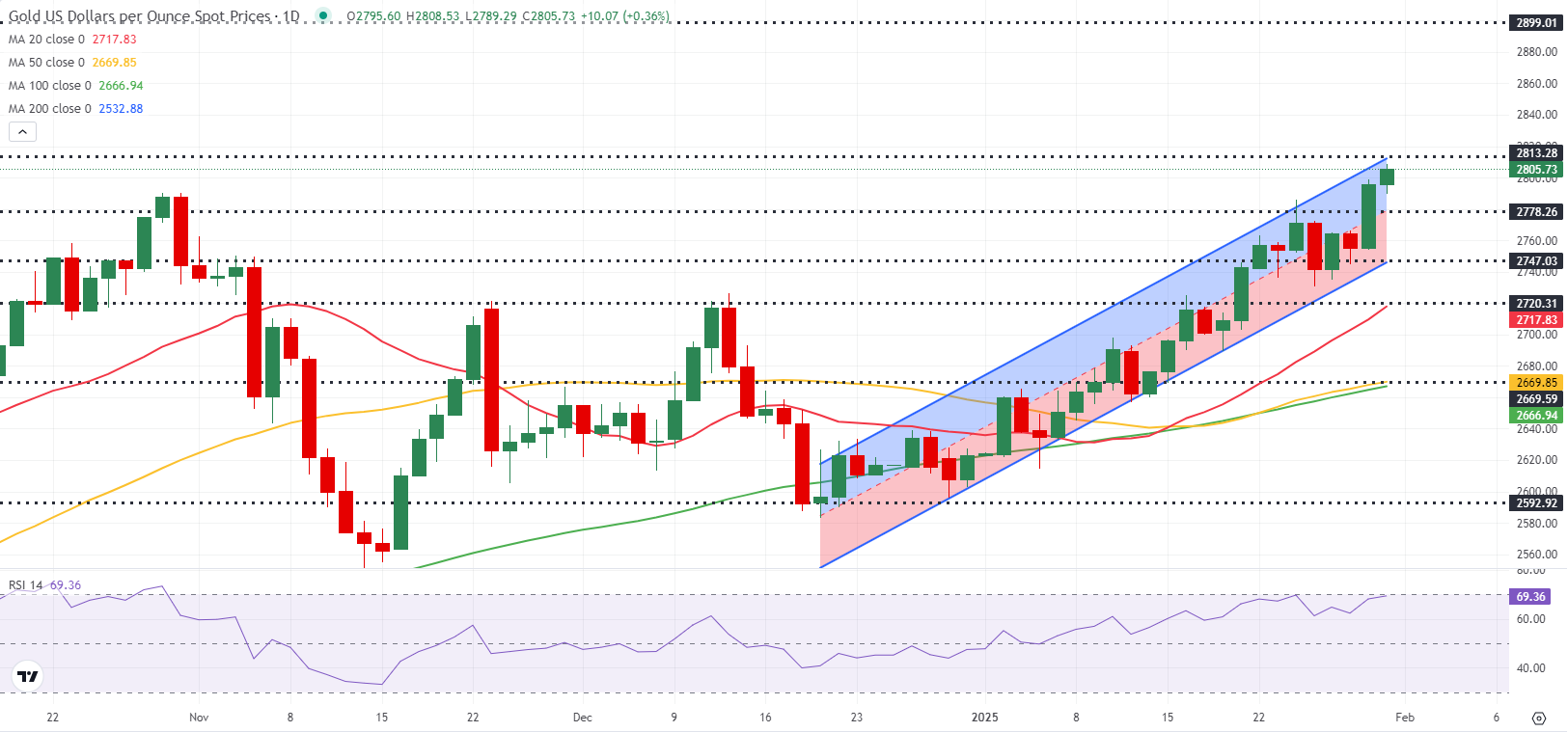- Gold touches a new record high as the US Dollar fails to benefit from Fed policy decisions.
- January US labor market data and headlines surrounding the Trump administration’s tariff policy could drive Gold’s valuation next week.
- The near-term technical outlook suggests that the bullish bias remains intact.
After struggling to build on the previous week’s gains early in the week, Gold (XAU/USD) gathered bullish momentum and set a new record high above $2,800 on Friday. Fresh developments regarding US President Donald Trump’s economic policies and January labor market data from the US could impact the precious metal’s valuation next week.
Gold gathers bullish momentum, sets new all-time-high
The US Dollar (USD) benefited from the cautious market mood at the beginning of the week, causing XAU/USD to erase a portion of the previous week’s gains. The Wall Street Journal reported that Trump’s advisers were not willing to negotiate or hold any talks with either Canada or Mexico and go ahead with 25% tariffs as soon as February 1. Meanwhile, the heavy selling pressure surrounding US technology stocks on news of China’s DeepSeek AI model outperforming western rivals Meta’s Llama 3.1, OpenAI’s GPT-4o and Anthropic’s Claude Sonnet 3.5 further boosted the USD demand.
US Treasury Secretary Scott Bessent said late Monday that he is pushing for universal tariffs on imports to start at 2.5% and rise gradually, per the Financial Times. In response to this comment, President Trump told reporters that he wants tariffs “much bigger than 2.5%,” adding that he hasn’t yet decided on the level. Although these comments helped the USD hold its ground in the first half of the day on Tuesday, the recovery seen in Wall Street’s main indexes weighed on the currency and opened the door for a rebound in XAU/USD.
Following the January meeting, the Federal Reserve (Fed) announced on Wednesday that it left the interest rate unchanged in the 4.25%-4.5% range, as widely expected. In its policy statement, the Fed removed the language suggesting inflation had “made progress” toward its 2% target, instead stating that the pace of price increases “remains elevated.” While responding to questions from the press later, Fed Chairman Jerome Powell said that there was elevated uncertainty because of significant policy shifts. “We don’t need to be in a hurry to make any adjustments,” he added. The Fed event failed to boost the USD, and Gold ended the day virtually unchanged.
On Thursday, US Treasury bond yields turned south after the disappointing US growth data, allowing Gold to gather bullish momentum. The US Bureau of Economic Analysis (BEA) reported that the US Gross Domestic Product expanded at an annual rate of 2.3% in the fourth quarter of 2024. This reading followed the 3.1% expansion recorded in the third quarter and came below the market estimate of 2.6%.
After rising more than 1% on Thursday, Gold stretched higher and touched a new record peak above $2,800 on Friday. As the USD managed to stay resilient against its peers after the latest data of the week from the US showed that the core Personal Consumption Expenditures (PCE) Price Index rose 2.8% in December as expected, Gold’s rally lost some steam.
Gold investors await US labor market data
The US economic calendar will feature ISM Manufacturing and Services Purchasing Managers Index (PMI) reports, December JOLTS Job Openings and January ADP Employment Change data in the first half of next week. Ahead of Friday’s highly-anticipated employment report, the market reaction to these data could remain short-lived. Better-than-expected figures are likely to support the USD and weigh on XAU/USD and vice versa.
In December, Nonfarm Payrolls (NFP) rose by 256,000. A disappointing NFP reading below 150,000 in January could revive concerns over a cooldown in the labor market and trigger a USD selloff with the immediate reaction. On the other hand, a print above 200,000 could be seen as good enough for the Fed to cling to its cautious approach to policy-easing, supporting the USD and dragging Gold lower.
Investors will also pay close attention to comments from Fed officials, now that the blackout period is over, and scrutinize fresh developments surrounding the Trump administration’s trade policies. In case President Trump announces tariffs on Mexican and Canadian imports over the weekend and repeats tariff threats on China, BRICS and Europe, markets could turn risk-averse to begin the week and support the USD, making it difficult for Gold to hold its ground.
According to the CME FedWatch Tool, markets are currently pricing in a less-than-20% probability of a 25 basis point (bps) Fed rate cut in March. In case policymakers leave the door open for a rate reduction at the next policy meeting, the USD could come under renewed selling pressure. On the flip side, the market positioning suggests that the USD doesn’t have much room left on the upside, even if Fed officials voice their willingness to stay on hold in March.
Gold technical analysis
The near-term technical outlook shows that Gold’s bullish outlook remains intact. The Relative Strength Index (RSI) indicator on the daily chart stays slightly below 70, suggesting that Gold could stretch higher before turning technically overbought. Additionally, XAU/USD remains within the upper half of the six-week-old ascending regression channel.
On the upside, $2,815 (upper limit of the ascending channel) could be seen as the next resistance before $2,900 (round level). In case the daily RSI rises above 70 when Gold tests $2,815, buyers could look to book their profits before reentering long positions, causing XAU/USD to stage a technical correction.
On the downside, immediate support is located at $2,780 (mid-point of the ascending channel) before $2,750 (lower limit of the ascending channel) and $2,720 (20-day Simple Moving Average).
Nonfarm Payrolls FAQs
Nonfarm Payrolls (NFP) are part of the US Bureau of Labor Statistics monthly jobs report. The Nonfarm Payrolls component specifically measures the change in the number of people employed in the US during the previous month, excluding the farming industry.
The Nonfarm Payrolls figure can influence the decisions of the Federal Reserve by providing a measure of how successfully the Fed is meeting its mandate of fostering full employment and 2% inflation. A relatively high NFP figure means more people are in employment, earning more money and therefore probably spending more. A relatively low Nonfarm Payrolls’ result, on the either hand, could mean people are struggling to find work. The Fed will typically raise interest rates to combat high inflation triggered by low unemployment, and lower them to stimulate a stagnant labor market.
Nonfarm Payrolls generally have a positive correlation with the US Dollar. This means when payrolls’ figures come out higher-than-expected the USD tends to rally and vice versa when they are lower. NFPs influence the US Dollar by virtue of their impact on inflation, monetary policy expectations and interest rates. A higher NFP usually means the Federal Reserve will be more tight in its monetary policy, supporting the USD.
Nonfarm Payrolls are generally negatively-correlated with the price of Gold. This means a higher-than-expected payrolls’ figure will have a depressing effect on the Gold price and vice versa. Higher NFP generally has a positive effect on the value of the USD, and like most major commodities Gold is priced in US Dollars. If the USD gains in value, therefore, it requires less Dollars to buy an ounce of Gold. Also, higher interest rates (typically helped higher NFPs) also lessen the attractiveness of Gold as an investment compared to staying in cash, where the money will at least earn interest.
Nonfarm Payrolls is only one component within a bigger jobs report and it can be overshadowed by the other components. At times, when NFP come out higher-than-forecast, but the Average Weekly Earnings is lower than expected, the market has ignored the potentially inflationary effect of the headline result and interpreted the fall in earnings as deflationary. The Participation Rate and the Average Weekly Hours components can also influence the market reaction, but only in seldom events like the “Great Resignation” or the Global Financial Crisis.









